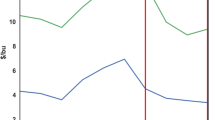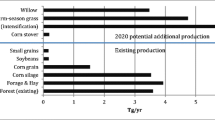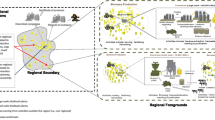Abstract
Integrated landscape management has emerged in recent years as a methodology to integrate the environmental impacts of various agricultural practices along with yield and profitability in a variety of cropping systems. In this study, the Landscape Environmental Assessment Framework (LEAF), a decision support toolset for use in integrated landscape management and developed at Idaho National Laboratory, was used to evaluate the profitability of grain-producing subfields, to determine the efficacy of sustainably harvesting residual biomass after grain harvest, and to determine the efficacy of integrating bioenergy crops into grain-producing landscapes to enhance farmer profitability. Three bioenergy crops, sorghum, switchgrass, and miscanthus, were integrated into non-profitable subfields in four US counties. The manuscript describes in detail the material and methods used to define crop rotations, land management units and practices, subfield units and productivity, grain profitability, sustainability criteria, energy crop integration, and feedstock cost estimation. With the integration of bioenergy crops, the overall annual biomass production rates in the four counties could be increased by factors ranging from 0.8 to 21, depending on the energy crop and county, over the annual residue biomass production rates. By modeling the harvesting of residual biomass and energy crops using geo-referenced, precision harvesting equipment and optimal harvesting paths on individual subfields, the average logistics costs including harvesting of both residual biomass and energy crops were observed to fall well below US DOE’s 2017 goals for biomass feedstock price of US$84/ton or US$92.6/dry Mg. Miscanthus, grown in counties in Ohio and Kansas, provided the maximum potential, among the three energy crops considered, for increment in biomass production and also posed maximum threat to the grain production. Considerable variability was observed in the harvesting and total costs because of the size, shape, and productivity of individual subfields. It was shown that variability in the harvesting costs could be used to down-select non-profitable farms with low harvesting costs and high residue and bioenergy crop yields and to reduce the negative impacts of bioenergy crop integration into croplands on grain production. The results of the assessment suggest that (1) the potential to produce biomass is considerably enhanced when non-profitable grain-producing subfields are replaced by bioenergy crops and (2) the subfield-scale integrated landscape assessment provides a defensible methodology to directly address individual farmer’s profitability, sustainability, and environmental stewardship.














Similar content being viewed by others
References
Sissine F (2007) Energy Independence and Security Act of 2007: a summary of major provisions, DTIC Document.
Schwab A (2016) Bioenergy Technologies Office Multi-Year Program Plan: March 2016, Bioenergy Technologies Office.
Heaton EA, Dohleman FG, Long SP (2008) Meeting US biofuel goals with less land: the potential of Miscanthus. Glob Chang Biol 14(9):2000–2014
Dale VH, Kline KL, Wright LL, Perlack RD, Downing M, Graham RL (2011) Interactions among bioenergy feedstock choices, landscape dynamics, and land use. Ecol Appl 21(4):1039–1054
Muth DJ, McCorkle DS, Koch JB, Bryden KM (2012) Modeling sustainable agricultural residue removal at the subfield scale. Agron J 104(4):970
Muth DJ, Bryden KM, Nelson RG (2013) Sustainable agricultural residue removal for bioenergy: a spatially comprehensive US national assessment. Appl Energy 102:403–417
Bonner IJ, Cafferty KG, Muth DJ, Koch JB, Karelen DL (2014a) Modeled impacts of cover crops and vegetative barriers on corn stover availability and soil quality. Bioenerg Res 7(10):6509–6526. doi:10.3390/en7106509
Muth DJ, Bryden KM (2013) An integrated model for assessment of sustainable agricultural residue removal limits for bioenergy systems. Environ Model Softw 39:50–69
Vogel KP (2004) Switchgrass. In: Moser LE, Burson BL, Sollenberger LE (eds) Warm-season (C4). Grasses. ASA-CSSA-SSSA, Madison, pp 561–588
Fedenko JR, Erickson JE, Woodard KR, Sollenberger LE, Venramini JMB, Gilbert RA, Helsel ZR, Peter GF (2013) Biomass production and composition of perennial grasses grown for bioenergy in a subtropical climate across Florida. USA Bioenerg Res 6:1082–1093
Kiniry JR, Anderson LC, Johnson MV, Behrman KD, Brakie M, Burner DM, Cordsiemon RL, Fay PA, Fritschi FB, Houx JH III, Hawkes C, Juenger T, Kaiser J, Keitt T, Lloyd-Reilley J, Maher S, Raper R, Scott A, Shadow A, West C, Wu Y, Zibilske LM (2013) Perennial biomass grasses and the Mason-Dixon line: comparative productivity across latitudes in the southern Great Plains. BioEnergy Res 6:276–291
Shoemaker CE, Bransby DI (2011) The role of sorghum as a bioenergy feedstock. In: R. Braun, D.L. Karlen, and D. Johnson (eds.) Sustainable Alternative Fuel Feedstock Opportunities, Challenges and Roadmaps for Six U.S. Regions. Proceedings of the Sustainable Feedstocks for Advanced Biofuel Workshop. Sept. 27–29, 2010. Atlanta, GA. Soil and Water Conservation Society, Ankeny, IA 50023 149–159.
Knoll JE, Johnson JM, Huang P, Lee RD, Anderson WF (2015) Effects of delayed winter harvest on biomass yield and quality of napiergrass and energycane. Biomass Bioenergy 80:330–337. doi:10.1016/j.biombioe.2015.06.018
Knoll JE, Anderson WF, Strickland TC, Hubbard RK, Malik R (2012) Low-input production of biomass from perennial grasses in the Coastal Plain of Georgia. USA Bioenerg Res 5:206–214
Mitchell RB, Schmer MR, Anderson WF, Jin V, Blakcom KS, Kiniry J (2016) Dedicated energy crops and crop residues for bioenergy feedstocks in the Central and Eastern USA. Bioenerg. Res. 9:384–398. doi:10.1007/s12155-016-9734-2
Gelfand I, Zenone T, Jasrotia P, Chen J, Hamilton SK (2011) Carbon debt of Conservation Reserve Program (CRP) grasslands converted to bioenergy production. Proc Natl Acad Sci U S A 108:13864–13869
Jungers JM, Fargione JE, Sheaffer CC, Wyse DL, Lehman C (2013) Energy potential of biomass from conservation grasslands in Minnesota, USA. PLoS One 8(4):e61209
Tillman D, Hill J, Kehman C (2006) Carbon-negative biofuels from low-input high-diversity grasslands biomass. Science 314:1598–1600
Corton J, Bühle L, Wachendorf M, Donnison IS, Fraser MD (2013) Bioenergy as a biodiversity management tool and the potential of a mixed species feedstock for bioenergy production in Wales. Bioresour Technol 129:142–149
Zhou XP, Xiao B, Ochieng RM, Yang JK (2009) Utilization of carbon-negative biofuels from low-input high-diversity grassland biomass for energy in China. Renew Sust Energ Rev 13:479–485
Barbosa B, Boleo B, Sidella S, Costa J, Duarte MP, Mendes B, Cosentino SL, Fernando AL (2015) Phytoremediation of heavy metal-contaminated soils using the perennial energy crops Miscanthus spp. and Arundo donax L. Bioenerg Res 8:1500–1511. doi:10.1007/s12155-015-9688-9
Werling BP, Dickson TL, Isaacs R, Gaines H, Gratton C, Gross KL, Liere H, Malmstrom CM, Meehand TD, Ruan L, Robertson BA, Robertson GP, Schmidt TM, Schrotenboer AC, Teal TK, Wilson JK, Landis DA (2014) Perennial grasslands enhance biodiversity and multiple ecosystem services in bioenergy landscapes. Proceedings of National Academy of Sciences (PNAS) 111(4):1652–1657
Hughes JK, Lloyd AJ, Huntingford C, Finch JW, Harding RJ (2010) The impact of extensive planting of Miscanthus as an energy crop on future CO2 atmospheric concentrations. GCB Bioenergy 2:79–88
Hedde M, van Oort F, Boudon E, Abonnel F, Lamy I (2013) Responses of soil macroinvertebrate communities to Miscanthus cropping in different trace metal contaminated soils. Biomass Bioenergy 55:122–129
Bourke D, Stanley DA, O’Rourke E, Thompson R, Carnus T, Dauber J, Emmerson M, Whelan P, Hecq F, Flynn E, Dolan L, Stout J (2014) Response of farmland biodiversity to the introduction of bioenergy crops: effects of local-factors and surrounding landscape context. GCB Bioenergy 6:275–289
Donnison IS, Fraser MD (2016) Diversification and use of bioenergy to maintain future grasslands. Food and Energy Security 5(2):67–75
Fernando AL, Boleo S, Barbosa B, Costa J, Duarte MP, Monti A (2015) Perennial grass production opportunities in marginal Mediterranean land. Bioenerg. Res. 8:1523–1537. doi:10.1007/s12155-015-9692-0
Dale VH, Kling C, Meyer JL, Sanders J, Stallworth H, Armitage T, Wangsness D, Bianchi T, Blumberg A, Boynton W, Conley DJ, Crumpton W, David MB, Gilbert D, Howarth RW, Lowrance R, Mankin K, Opaluch J, Pearl H, Reckhow K, Sharpley AN, Simpson TW, Snyder C, Wright D (2010) Hypoxia in the Northern Gulf of Mexico. Springer Series on Environmental Management. ISBN 0172-6161, ISBN 978-0-387-89685-4, e-ISBN 978-0-387-89686-1, DOI 10.1007/978-0-387-89686-1. Springer New York.
Smith VH, Tilman GD, Nekola JC (1999) Eutrophication: impacts of excess nutrient inputs on freshwater, marine, and terrestrial ecosystems. Environ Pollut 100(1–3):179–196
Min QW, Jiao YL (2002) Effects of agricultural non-point source pollution on eutrophication of water body and its control measure. Acta Ecological Sinica:2002–2003
Jager HI, Baskaran LM, Schweizer PE, Turhollow AF, Brandt CC, Srinivasan R (2015) Forecasting changes in water quality in rivers associated with growing biofuels in the Arkansas-White-Red river drainage, USA. GCB Bioenergy 7:774–784. doi:10.1111/gcbb.12169
Dodds WK, Oakes RM (2008) Headwater influences on downstream water quality. Environ Manag 41:367–377
Negri MC (2016) Bioenergy Sustainability and the Food, Energy, Land and Water Nexus. Presented at DOE’s Bioenergy Solutions to Gulf Hypoxia Workshop. Aug 30–31, 2016, Washington, DC
Wu M (2016) Modeling water quality in the Mississippi River Basin: Upper Mississippi, Ohio, and Missouri River Basins. Presented at DOE’s Bioenergy Solutions to Gulf Hypoxia Workshop. Aug 30–31, 2016, Washington, DC.
McIsaac GF (2016) Framing the problem: nutrient source identification, accounting, and attribution. Presented at DOE’s Bioenergy Solutions to Gulf Hypoxia Workshop. Aug 30–31, 2016, Washington, DC
Demissie Y, Yan E, Wu M, Zhang Z (2012) Watershed modeling of potential impacts of biofuel feedstock production in the Upper Mississippi River Basin. Environmental Sciences Division, Argonne National Laboratory Report, ANL/EVS/AGEM/TR-12-07, April 2012.
Nocentini A, Virgilio ND, Monti A (2015) Model simulation of cumulative carbon sequestration by switchgrass (Panicum virgatum L.) in the Mediterranean area using the DAYSENT model. Bioenerg Res 8:1512–1522. doi:10.1007/s12155-015-9672-4
Cosentino SL, Copani V, Scalici G, Scordia D, Testa G (2015) Soil erosion mitigation by perennial species under Mediterranean environment. Bioenerg Res 8:1538–1547
Blanco-Conqui H, Gantzer CJ, Anderson SH, Alberts EE, Thompson AL (2004) Grass barrier and vegetative filter strip effectiveness in reducing runoff, sediment, nitrogen, and phosphorus loss. Soil Sci Soc Am J 68:1670–1678
Selman, M. (2016) Office of environmental markets: Water quality trading and synergies with BETO. Presented at DOE’s Bioenergy Solutions to Gulf Hypoxia Workshop. Aug 30–31, 2016, Washington, DC.
Reed D (2016) Supply and demand for ecosystem credits. Presented at DOE’s Bioenergy Solutions to Gulf Hypoxia Workshop. Aug 30–31, 2016, Washington, DC
Fox J (2016) Monetizing ecosystem services and other challenges. Presented at DOE’s Bioenergy Solutions to Gulf Hypoxia Workshop. Aug 30–31, 2016, Washington, DC
Biomass Crop Assistance Program (BCAP). https://www.fsa.usda.gov/programs-and-services/energy-programs/BCAP/index (accessed on December 01, 2016).
Millennium Ecosystem Assessment (2005) Living beyond our means: natural assets and human well-being. Island Press, Washington
Mueller ND, Gerber JS, Johnston M, Deepak KR, Ramankutty M, Foley JA (2012) Closing yield gaps through nutrient and water management. Nature (Published online 29 August 2012) doi: 10.1038/nature 11420.
Follett FF, Vogel KP, Varvel GE, Mitchell RB, Kimble J (2012) Soil carbon sequestration by switchgrass and no-till maize grown for bioenergy. Bioenerg Res 5:866–875
Bonner IJ, Muth DJ, Tomer MD, James DE, Porter SA, Karelen DL (2014b) Opportunities for energy crop production based on subfield scale distribution of profitability. Energies 7(10):6509–6526. doi:10.3390/en7106509
Bonner IJ, Mcunn G, Muth DJ, Tyner W, Leirer J, Dakins M (2016) Development of integrated bioenergy production systems using precision conservation and multimedia decision analysis techniques. J Soil and Water Conserv 71(3):180–191
Rooney WL (2000) Sorghum. Cellulosic Energy Cropping Systems:109–129
McKendry P (2002) Energy production from biomass (part 1): overview of biomass. Bioresour Technol 83(1):37–46
Revised Universal Soil Loss Equation, Version 2 (RUSLE2), Official NRCS RUSLE2 Program. Official NRCS Database. http://fargo.nserl.purdue.edu/rusle2_dataweb/RUSLE2_Index.htm.
Scheffe L, Ferruzzi G, Boetger S, and Woodruff S (2015) RUSLE2 advanced data management. http://fargo.Nserl.Purdue.Edu/RUSLE2_ftp/NRCS_Base_Database/RUSLE2%20Instructional%20Mat erial/training%20Presentations/RUSLE2%20Advanced%20Data%20Management.Pptx.
Cotton News (2011) County production figures https://www.plainscotton.org/esw/news/cotnewsback/2012/CN120511.htm.
Jacobson JJ, Roni MS, Lamers P, Cafferty KG (2014) Biomass feedstock and conversion supply system design and analysis. Idaho National Laboratory, Idaho Falls, ID. INL/EXT-14-32377.
Cafferty KG, Muth DJ, Jacobson JJ, Bryden KM (2013a) Model Based Biomass System Design of Feedstock Supply Systems for Bioenergy Production. In: ASME 2013 International Design Engineering Technical Conferences and Computers and Information in Engineering Conference, August 4–7. Portland, OR, USA
University of Georgia’s Extension Engineering Handbook. http://www.caes.uga.edu/departments/bae/extension/handbook/#geninfo.
Hanna M (2016) Estimating the field capacity of farm machines. Iowa State University, Extension and Outreach, Ames, IA. PM 696. Available from https://www.extension.iastate.edu/agdm/crops/pdf/a3-24.pdf.
Acknowledgments
This work was supported by the US Department of Energy’s Office of Energy Efficiency and Renewable Energy, Bioenergy Technologies Office, under DOE Idaho Operations Office Contract DE-AC07-05ID14517. Accordingly, the US Government retains a nonexclusive, royalty-free license to publish or reproduce the published form of this contribution, or allow others to do so, for US Government purposes. The authors would also like to acknowledge the analytical support provided by AgSolver to this study.
Author information
Authors and Affiliations
Corresponding author
Rights and permissions
About this article
Cite this article
Nair, S.K., Hartley, D.S., Gardner, T.A. et al. An Integrated Landscape Management Approach to Sustainable Bioenergy Production. Bioenerg. Res. 10, 929–948 (2017). https://doi.org/10.1007/s12155-017-9854-3
Published:
Issue Date:
DOI: https://doi.org/10.1007/s12155-017-9854-3




